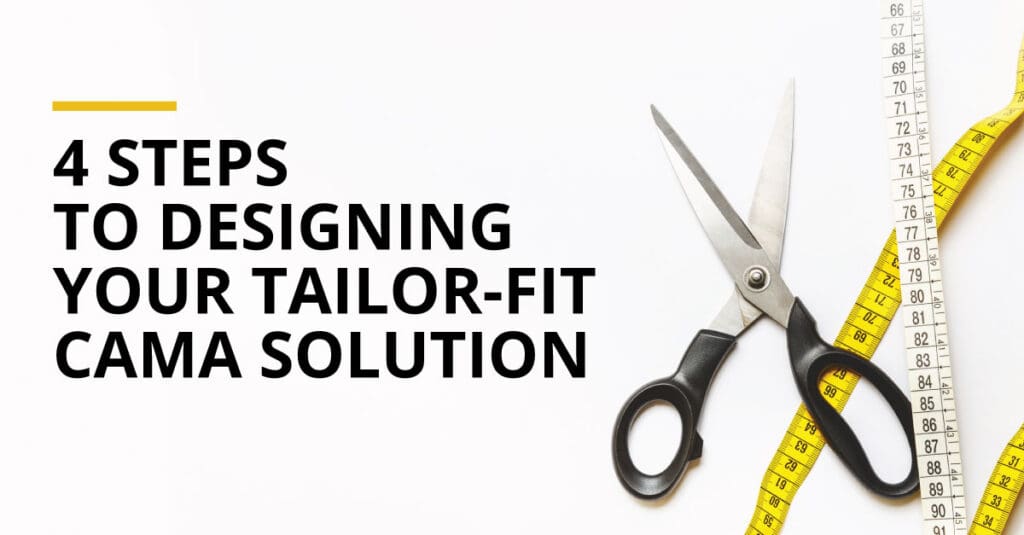The question almost always comes, no matter who I’m talking with, where they’re from, or the status of their current CAMA solution. Assessors want to know: How can they be sure they’ll get what they really need from a new CAMA solution?
Borne of the frustration of assessors’ past experiences, the question is entirely legitimate — and entirely appropriate in the face of transitioning to any new CAMA solution. But I want to speak most immediately to the answer as it pertains to tailor-fit CAMA solutions.
Tailor-fit CAMA solutions have some particular characteristics that help ensure you get what you need, as discussed in a previous blog. They:
- Start with a comprehensive and proven set of software modules
- Provide customizations to meet your organization’s specific needs
- Give you ownership — and therefore control — of the system
Combining most of the pros and mitigating (or eliminating) most of the cons of off-the-shelf and built-from-scratch solutions, tailor-fit solutions are often the best option when it comes to replacing your CAMA software. And the key to ensuring your organization’s needs will be fully met is incorporating four critical steps when designing your tailor-fit CAMA solution.
Step #1: Review Your Assessment Process
The first and most critical step is reviewing your organization’s current assessment process to gain a clear and comprehensive understanding of your business processes, requirements, challenges, and goals. This should happen interactively with your new CAMA solution provider as you move through your organization’s workflows using your current software solution, and they observe, document, and ask questions — listening carefully to your answers.
It’s essential that your solution provider learn which processes are working for your organization and which ones aren’t. Then they should determine where there are gaps between what your current software does and what you need your new CAMA solution to do. Finally, they should ask you for insight into any unique aspirations you may have for your new solution.
By taking the time to sit down, side by side (or computer by computer, these days!), and talking through every aspect of your assessment process, your solution provider should gain a deep and complete understanding of your business processes and a crystal-clear picture of what you need and want in a new CAMA solution.
Step #2: Clarify Your Objectives and Desired Improvements
The next step has two parts. First, translating the picture from step #1 into a preliminary expectations document that lays out the objectives and desired improvements identified in the assessment process review. Second, allowing CAMA solution stakeholders the opportunity to provide corrections, clarifications, or further explanations to the interpretation of your organization’s objectives and desired improvements.
By restating and summarizing essential information from the review step and validating those findings, you and your solution provider should come to a common understanding of exactly what a new CAMA solution needs to do to fully meet your organization’s needs.
Step #3: Demonstrate Your CAMA Solution
The third step, based on the common understanding achieved in the previous step, is demonstrating how a new, tailor-fit CAMA solution would work for you. During this demonstration, your solution provider should strive to:
- Validate the ability of the new CAMA solution to meet most, if not all, of your organization’s objectives and desired improvements
- Propose feature enhancements — tailoring — where there are gaps between what the new solution can currently do and what you need it to do
- Explore out-of-the box, innovative features that may meet your organization’s unique aspirations for a new CAMA solution
By observing and discussing exactly how the new CAMA solution will work for your organization, your goal is to fortify your — and your solution provider’s — understanding of the method and capacity of the new solution to meet your needs.
Step #4: Deliver Your CAMA Solution Plan
Following the demonstration of a viable solution for your organization, the fourth step is putting together your CAMA solution plan. This plan should be a formal document that details:
- Solution objectives
- Product features and capabilities
- Implementation plans and schedules
- Support and maintenance plans
- Fixed-cost solution pricing from your solution provider
By documenting all the information about what you’ll get, when and how you’ll get it, and how much you’ll have to pay for it, along with details about how your solution provider will support your new CAMA solution post-implementation, you can ensure clarity and transparency before your final commitment is required and the “real” work begins.
What’s Next
We understand that many assessors feel wary as they think about and begin the search for a new CAMA solution — it’s a big undertaking! And it’s certainly worth the time to consider what options are best for your organization. When it comes to a tailor-fit solution, the four critical steps outlined above are designed to give you confidence, to assure you that your organization will get what it really needs from your new CAMA solution.
Interested in working with us to design your tailor-fit CAMA solution? Or not sure how a CAMA tailor-fit solution might work for your organization? Either way, reach out to me here. Farragut can help guide you through this consequential decision. We want to help your organization reach its full potential.





